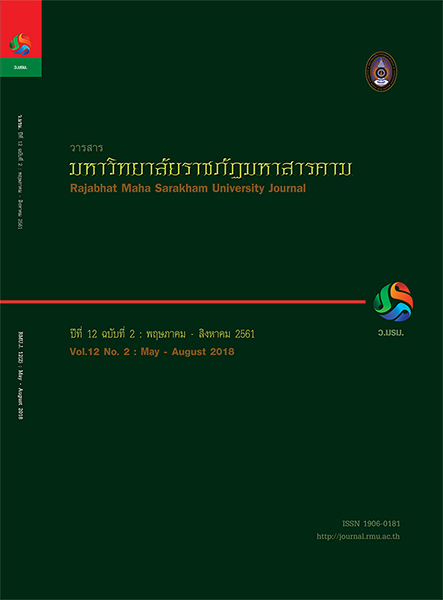Development of Sunday Buddhist School Model Based on Virtues Conducive to Growth (Vuddhi-Dhamma)
Main Article Content
Abstract
The objectives of the research were (1) to study the state of problems and needs for development of the
Buddhist Sunday School model based on Virtues Conducive to Growth (VuddhiDhamma), (2) to create the
curriculum for development of the Buddhist Sunday School model based on Virtues Conducive to Growth,
and (3) to assess the curriculum on development of the Buddhist Sunday School model based on Virtues
Conducive to Growth. The research was conducted by the mixed method of the qualitative research and
the quantitative research. The research duration was divided into three phrases: the target group at the first
phrase was 20 villagers in Tha Song Khorn sub-district and the samples at the third phrase were 40 students
of the Buddhist Sunday School. The research instruments used for collecting the data were the Focus Group
Discussion, the Curriculum Assessment for Development of the Buddhist Sunday School Model Based on
Virtues Conducive to Growth, approved by the experts, and the Satisfaction Assessment of Students for the
Curriculum on Development of the Buddhist Sunday School Model Based on Virtues Conducive to Growth.
The statistics used for analyzing the data were mean, percentage and standard deviation while the research
results were presented in the tabular format and the descriptive analysis.
The research findings were as follows: 1) The state of problems for NongKhuen Chang villagers,
especially the social problem, was found to be at the highest level. It was that children and youth spent
useless leisure-time by playing games and roaming in department stores; therefore, the Buddhist Sunday
School was required to offer such subjects as the Life of Buddha, the Dhamma, Five Precepts and Five Virtues,
Preservation of the Northeastern Food (JaewBong – Spicy Minced Fermented Fish), Home Working: Pleated
Fabric Catching, and Local History, in order that those children and youth would spend useful leisure-time.
2) Apart from synthesizing related research documents and reviews, including the first-phrase focus group
discussion, the curriculum design for the Buddhist Sunday School based on Virtues Conducive to Growth
was found that such subjects as the Life of Buddha, the Dhamma, Five Precepts and Five Virtues, Preservation
of JaewBong (the Northeastern Food), Home Working: Pleated Fabric Catching, and Local History were
taught under the process of teacher preparation, in which there was a meeting of teachers before learning
and teaching in order to cooperate on planning to teach and integrate related subjects. Each of the teaching
methods: Lecture Method, Demonstration Method or Learning by Doing, was based on the process of Virtues
Conducive to Growth, which were as follows: (1) Suppurisamseva or association with a good and wise man
- a teacher of local wisdom was sought to teach students a specific knowledge. (2) Saddhammassavana or
listening to the good teaching - after a good teacher was met, it was important for students to pay attention on
reflection – this was referred to the student’s profound consideration of the teacher’s teaching. This process
was also dependent upon the teacher’s assessment whether the students could describe the right content
and give correct answers. (4) Dhammanudhammapatipatti or the practice in accord of all levels and aspects
of the Dharmaor what was taught – this was the practice of what was taught in accordance with the learning
objectives. This was the practice by doing to test whether the teacher’s teaching could be completed correctly.
Dependent upon each subject, there were various instruments and media to enhance learning and
teaching, including such integrated media as pictorial books, videos, projectors and computers, as well as
the fieldwork. The overall curriculum suitability was found to be at a reasonable level of 0.85. 3) The student’s
satisfaction with the curriculum for the Buddhist Sunday School based on Virtues Conducive to Growth was
found to be overall at a high level with the mean scores of 3.81.
his teaching. This process was dependent upon the teacher’s assessment. (3) Yonisomanasikara or critical
Article Details
1. All articles undergo a thorough with at least three reviewers evaluating their suitability within the respective field of study, during the double-blind review.
2. The views expressed by individual authors do not represent the official views of the Editorial Boards of RMUJ: The author of each articie is responsible for all its contents.
3. The Editorial Boards do not reserve the copyrights. but proper citations need to be made.
References
the operation of Buddhist Sunday Center. Bangkok
: Religion, Printing House.
[2] Phrapromkunaporn (P.O. Payuto). (2004). Intelligent
Development : Religion - History. Post Today,
(Sunday 14 November, 254
[3] Phramaha ThaveeKuntaweero (Torasing). (2000).
Assessment of Buddhist Sunday School
Curriculumof Mahachulalongkornrajavidyalaya
Universityand Branches in Bangkok. Master of
Education Thesis : Mahasarakrm university.
[4] Joyce, B. and Weil, M. (1996). Model of Teaching.
3rd. Englewood Cliffs, New Jersey : Prentice-Hall.

